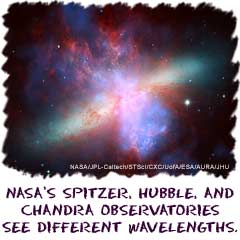|
|
||||||||||||||||||
 |
|

|
||||||||||||||||
Looking At Galaxies We've already covered the universe. Let's focus on something smaller, a galaxy. Right now, you're sitting on a planet that orbits a star in the Milky Way galaxy. As you know, there are loads of galaxies in the universe. Each is different from the other, like fingerprints. We're going to talk about a few of the common traits of galaxies and how you can look up in the sky and look for other galaxies.
We've already covered the universe. Let's focus on something smaller, a galaxy. Right now, you're sitting on a planet that orbits a star in the Milky Way galaxy. As you know, there are loads of galaxies in the universe. Each is different from the other, like fingerprints. We're going to talk about a few of the common traits of galaxies and how you can look up in the sky and look for other galaxies.
Grouping Stars And SystemsOrganized galaxies are made of millions of stars and systems. While we can't take a picture of our galaxy, astronomers use a variety of telescopes to study nearby galaxies. They use several wavelengths in the EM spectrum to see which stars are closer and further away. While you may think of Hubble's pictures that show visible light, great discoveries have been made by Spitzer studying galaxies in infrared light and Chandra detecting x-rays.More Than Meets The EyeAs astronomers have studied galaxies in detail, they have determined that there is more than dust, stars, and systems. They currently believe that about 90 percent of the matter in galaxies is called "dark matter." Dark matter is matter that does not emit any radiation that can be detected using current instruments. We know that dark matter exists because of the gravity exerted on other objects. If you want to work on the cutting edge of astronomy, you might want to look into the study of dark matter and dark energy. |

|
|||||||||||||||||
Useful Reference MaterialsEncyclopedia.com:http://www.encyclopedia.com/topic/galaxy.aspx Wikipedia: http://en.wikipedia.org/wiki/Galaxy Encyclopædia Britannica: http://www.britannica.com/EBchecked/topic/223818/galaxy NASA: http://science.nasa.gov/astrophysics/focus-areas/what-are-galaxies/ STSCI/Hubble: http://amazing-space.stsci.edu/capture/galaxies/ Cambridge University: http://www.damtp.cam.ac.uk/research/gr/public/gal_home.html | ||||||||||||||||||
|
RETURN TO TOP or Search for more information... * The custom search only looks at Rader's sites. |
|||||||||||||||||
©copyright 1997-2015 Andrew Rader Studios, All rights reserved. Current Page: Cosmos4Kids.com | Galaxies | Introduction |
||||||||||||||||||
|
|
||||||||||||||||||

